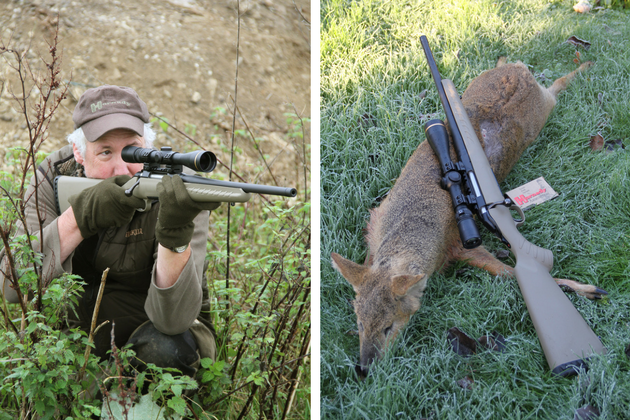Deer seasons in the UK. When can deer be hunted?
The deer seasons in the UK have been precisely organised to give deer protection when they need it, to produce…
Win CENS ProFlex DX5 earplugs worth £1,149 – enter here
If I have to use my rifle to despatch an injured deer, what's the best way of doing it?

Always remember that safety comes first. Make sure there is a safe backstop in the form of soft ground to catch the bullet and if there are members of the public present, appoint someone to keep them well back. Always bear in mind many people will be distressed at the thought – let alone the sight – of an animal being killed.
The farther away you can keep any bystanders, the better it will be.
The shot should be to the animal’s brain. If the deer’s head is side-on, then the shot is through the base of the ear (through, not below) and lined up with the same spot on the other side. If you have to shoot from above and behind, then go through the base of the skull into the brain.
You can find the correct spot by feeling the back of your own head and finding the ridge where the cervical column enters the skull; that’s the place to go. Always ensure you are lined up correctly and that the bullet will go into the backdrop. From in front, it is just the previous shot in reverse and you need to be able to visualise the head in three dimensions to get it right.
On no account allow the rifle’s muzzle to actually touch the deer; always leave a bit of air space between.
The deer seasons in the UK have been precisely organised to give deer protection when they need it, to produce…
At the end of the rut a yearling buck on my ground was still in dark velvet and showed no…
Stalking trends come and go. From calibres to optics, all have their time. Fashion also influences the shots we take,…
The Deer Act says that you will not commit an offence by going on to someone else’s land to retrieve a deer or to shoot it to end its suffering, provided that you shot it lawfully and provided that you have reason to believe that the landowner would have given his consent, had it been possible to ask him.
The problem is that unscrupulous stalkers can use this to poach deer across the boundary so it can cause a great deal of ill-feeling.
There is also the slight difficulty that the carcass then rightfully belongs to the owner of the land upon which it fell, which can cause even more ill-feeling, on both sides.
If you don’t have a working arrangement with your neighbour avoid shooting a deer close to the boundary. If unaware of danger, and properly shot, a deer may well drop on the spot; but you must always allow for it to run after the shot, particularly if it has been alerted.
Q) Last week I shot a roebuck, which was standing on the bank that forms a boundary between my farm and that of my neighbour. The buck ran 20 yards and then collapsed in my neighbours field. Was I within my rights to recover it from there?
A) The bank must belong either to yourself or your neighbour. If the buck was on your ground, you were entitled to shoot it, but not if it was on your neighbours, or you would have committed civil and criminal offences. As for the recovery of the carcass, you must have entered your neighbours land to remove the roe. In the absence of an agreement with your neighbour, or a genuine, soundly based belief that he would not have minded, you had no right to set foot on his land without his permission, let alone follow up the buck. Though you may think of it as your buck, you may again be liable in civil law for trespass and guilty in criminal law of trespassing with a firearm and illegal carcass removal. Similar liabilities might apply if you fired from your land over ground belonging to another at a buck on land belonging to you but on the other side of it. This would at least be a case of constructive trespass. Usually, all the ensuing unpleasantness can be avoided by prior liaison with neighbours.
Get the latest news delivered direct to your door
Discover the ultimate companion for field sports enthusiasts with Shooting Times & Country Magazine, the UK’s leading weekly publication that has been at the forefront of shooting culture since 1882. Subscribers gain access to expert tips, comprehensive gear reviews, seasonal advice and a vibrant community of like-minded shooters.
Save on shop price when you subscribe with weekly issues featuring in-depth articles on gundog training, exclusive member offers and access to the digital back issue library. A Shooting Times & Country subscription is more than a magazine, don’t just read about the countryside; immerse yourself in its most authoritative and engaging publication.

